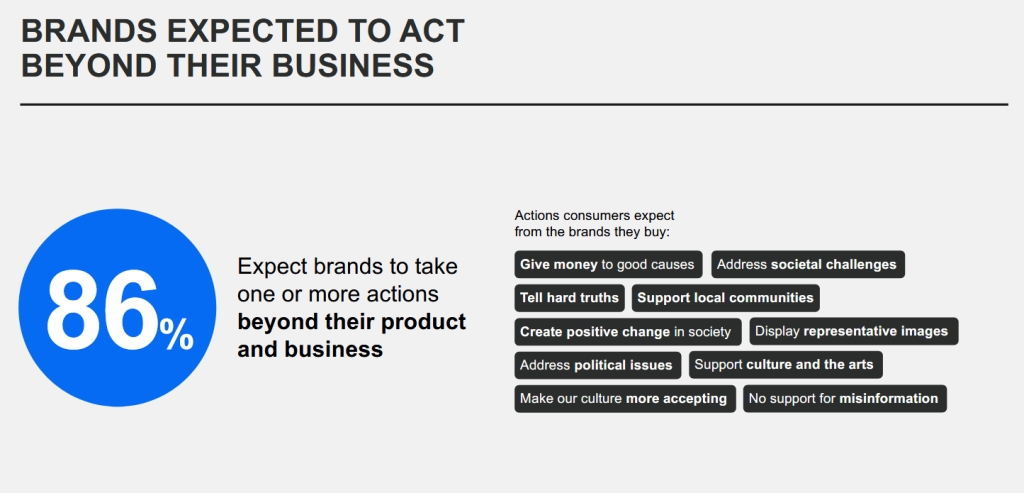- Home
- Science-Backed Marketing Insights
- The Psychology of Social Proof ...

Nobody wants to be bothered with complicated theories just to appear smarter. So, we understand that talking about behavioral economics, psychological theories, and social proof can sound a little intimidating. However, some theories are there and are prominent for a good reason. Understanding why and how your potential buyers come to their conclusions can lead to some very practical outcomes. Social proof in marketing is one of these concepts: understanding why it works can help marketers figure out how to actually apply it.
In short, people tend to mimic the actions of others. That’s the essence of social proof—and the reason it shows up everywhere from customer testimonials to product labels. But what is social proof in marketing, really? And how can you use it in a way that’s more meaningful than just adding a star rating to your email footer?
In this article, we’ll explore this concept on a deeper level. You’ll find clear, real-world social proof examples and practical advice for how to use them in email campaigns. Every insight here is grounded in behavioral research, psychological theory, and data-driven evidence. If that sounds boring, you’ll be surprised to find out that science can be not only insightful but also fun.
What Is Social Proof in Marketing?
Social proof is the psychological phenomenon where people mimic the actions of others, assuming that those actions reflect correct behavior. In marketing, this becomes a potential leverage, the one that signals trust, reduces perceived risk, and accelerates decision-making.
The formal concept of social proof has roots in both psychology and economics. In simple terms, social proof theory is the idea that people tend to follow the actions and choices of others—particularly in uncertain or ambiguous situations. But the marketing application of this theory is both more strategic and more structured. It’s about creating evidence that your product or service is already valued by others—and positioning that evidence where it matters most.
The role of social signals in decision-making
Consumers often must make fast decisions with very limited information on hand and often minimal or no personal experience. In this case, social proof acts as heuristics—shortcuts that let the brain decide faster. Just as we often decide to step into a restaurant that’s full rather than an empty one, your audience is more likely to engage with your offer if it’s supported by community trust. A 2021 Edelman Trust Barometer report found that 81% of consumers are more likely to believe a company is trustworthy if other people do. Moreover, the rise of AI-generated content, fake reviews, and digital fatigue has made consumers more skeptical than they were just a few years ago.
Social proof can come in different forms: it can be a customer testimonial in an email, a review next to a product photo, or a Most Popular Plan badge on a pricing page. No matter how you decide to represent it, social proof serves as a trust amplifier, a signal that tells us, “This is a good thing, and you have no reason to doubt it.”
The Science Behind Social Proof and Herd Behavior
At the core of social proof is a simple idea: when uncertain, people look to others for cues on how to act. This ancient but surprisingly powerful instinct forms the basis of both psychological theory and high-performing marketing strategies.
Cialdini’s theory of social proof
In his seminal work Influence: The Psychology of Persuasion, psychologist Robert Cialdini identified social proof as one of six universal principles of influence. When individuals are uncertain about what to do, they often assume the actions of others reflect the correct behavior—especially when those others seem similar to themselves or are perceived as authoritative.
In Cialdini’s words, “When we are uncertain, we are willing to place an enormous amount of trust in the collective knowledge of the crowd.” This principle is particularly strong in moments of ambiguity, urgency, or limited information, which also are common features of consumer online decision-making.
Herd behavior: Insights from behavioral economics
Apart from psychology, social proof also sits at the heart of herd behavior, a concept formalized in behavioral economics by Abhijit Banerjee and Sushil Bikhchandani in the early 1990s. Their research explained how individuals often disregard their private information and instead mimic the choices of those before them, especially in sequential decision-making settings. This creates informational cascades, where the first few signals determine the actions of a crowd, regardless of actual value. In the context of marketing, this theory helps explain why a product with hundreds of five-star reviews gets chosen over an equally good but unrated alternative.
Neuroscience, uncertainty, and the pull of the crowd
Recent neuroscientific studies support this behavioral lens. Research using fMRI has shown that conforming to others’ opinions activates the striatum, a brain region associated with reward processing. In other words, agreement with the crowd feels good on a neurological level. Conversely, deviating from group consensus can trigger conflict-processing regions such as the anterior cingulate cortex—essentially registering as a psychological risk.
This neurological basis links closely to concepts like fear of missing out (FOMO) and social risk aversion, both of which amplify the effects of social proof in email campaigns. When recipients see that “32,000 marketers already signed up” or that a webinar is “90% full,” their brains register urgency, reward, and potential loss—making them more likely to act.
Real-World Examples of Social Proof in Email Marketing
TripAdvisor

Being literally the platform built around people’s experiences, TripAdvisor is living proof of just how powerful social proof can be. In the email above, the brand uses a blend of quantitative and qualitative cues to guide the recipient’s decision-making process. When users see both types of validation side by side, it doesn’t just signal popularity—it suggests that real people had real, positive experiences. And that is worth paying attention to.
Another subtle but clever element is the inclusion of user profile icons in the header. These act as small but meaningful signals that the reviews are genuine, coming from individuals rather than anonymous metrics. This detail taps into something deeper than just decision-making—it evokes a quiet sense of social belonging. In this context, seeing others’ feedback affirms that you’re not the only one navigating uncertainty.
Puma

Here, Puma demonstrates one of the more interactive social proof marketing examples. It does not show what others liked—it invites subscribers to participate. In the email above, each sneaker is accompanied by a heart icon showing in real time how many people voted for it. This simple interface transforms a static product showcase into something dynamic.
This email is an example of dynamic social proof, where decisions are influenced not just by what others have done, but by what others are currently doing.
It also adds something equally important: a sense of inclusion. Voting is framed as a communal act: by showing how “other PUMAs are voting,” the email positions the subscriber as part of a broader, fashion-conscious community.
Gucci

Being a luxury brand, Gucci takes a very different stance on social proof: it does not say, “Thousands are wearing this”; it simply shows a creative insider wearing its apparel. Here the visual combined with a short storytelling is doing the main job by saying, “This is what’s relevant. This is what tastemakers choose.” That’s a type of social proof rooted in cultural capital.
For luxury brands, this approach is especially effective, as their target audience responds more to symbolism, to placement within the right context, to the sense that something belongs to a more exclusive world.
How Social Proof Boosts Email Metrics
Higher open rates: The power of belonging in the subject line
Data from the Nielsen Norman Group shows that users scan inboxes in milliseconds, relying on subtle social signals to decide what to open. Subject lines that imply group participation or popularity can trigger an effect that behavioral scientists call informational conformity—the tendency to follow the crowd when lacking a clear directive.
Compare:
❌ Exclusive Deal Just for You
✅ Join 8,000+ Creators Who Switched to Our Tool
In contrast to the first line, the second one implies that others are already benefiting. That makes it so much more powerful. That explains why subject lines that include social proof increase open rates by up to 22% compared to those without any external validation.
Click-through rates (CTR)
Click-through rates often depend less on the beauty of your copy and more on the perceived risk of clicking. Social proof in this case works as a psychological antidote that lowers that perceived risk.
Booking.com proved this by simply adding messages like “Booked 4 times in the last 24 hours” near hotel listings. This behavioral test significantly increased CTR and engagement. In email, this technique works through clickable trust signals, such as testimonials, review counts, or even digital badges (Trusted by 50K+).

Conversion rates: The final mile of influence
Social proof doesn’t just influence buying behavior; it also changes the calculus of risk. According to a landmark study by the Spiegel Research Center at Northwestern University, displaying reviews can increase conversion rates by as much as 190% for lower-priced items. But the effect becomes even more pronounced for more expensive purchases: products with a higher price point showed conversion lifts of up to 380% when accompanied by customer reviews.
These findings prove that the more someone has to lose—financially, emotionally, or reputationally—the more they rely on the collective experience of others. When a potential buyer is weighing a significant investment, testimonials and ratings turn into essential validation tools.

Why these numbers keep compounding
The psychological engine behind these metrics is cumulative. Once social proof gets someone to open an email, it smooths the path to clicking. Once clicked, the sense that others have walked this path encourages follow-through. From the brain’s point of view, each micro-decision is being outsourced to the tribe.
This is why social proof email examples that layer multiple forms, such as subject line validation, mid-email testimonial, and post-click case study, often outperform single-shot efforts.
The Dark Side of Social Proof: Where Persuasion Turns into Manipulation
Studies in behavioral economics have shown that when individuals are placed under conditions of uncertainty, their reliance on others’ decisions increases significantly. People may ignore their own preferences in favor of following what appears to be the group consensus—even when that consensus is artificially manufactured.
In the context of email marketing, unverified popularity claims or selectively highlighted testimonials can easily trigger this dynamic. So, what happens when a number of happy customers becomes inflated and the urgency manufactured? You may still get the click, but you might lose something far more valuable: trust.
In a 2021 consumer trust survey by Edelman, 68% of respondents reported that trusting a brand is more important for them than it used to be. Moreover, many people indicate that it is important for them to see brands committing to a good cause or supporting we values to be trusted.

The challenge with social proof is mostly ethical. You can always find a way to say, “Over 10,000 sold,” even if half were through giveaways. You can also use half-truths: highlight your happiest customer and omit the rest. But if you do this often enough, your brand image starts drifting further and further away from your actual intentions. It starts to feel rehearsed, then over-rehearsed, and after a while customers stop opening your emails altogether.
Actionable Tips for Using Social Proof in Email Campaigns
📌 Anchor statistics in human experience
Social proof becomes significantly more efficient when quantitative signals are combined with qualitative detail. While large numbers can establish scale, what makes them matter for others is being accompanied by a human voice.
📌 Use testimonials with context
Generic praises, like “Amazing service!” rarely move behavior. Instead, select testimonials that provide situational specificity: “I switched from [X], and within two weeks saw a 30% lift in engagement.” This way, a review turns into actual proof.
📌 Place proof near the point of hesitation
Behavioral research suggests that friction most often occurs at the decision point—right before the click. That’s where social proof should be. Placing reviews or client logos directly above the CTA is a way of reducing the cognitive cost of committing.
📌 Don’t overuse urgency unless it’s structurally true
The relationship between urgency and social proof requires care. When used honestly and in moderation, it can create helpful momentum. But when urgency is overused or lacks real backing, it starts to feel like pressure.
📌 Name the source—trust follows transparency
When you quote a review, mention where it came from. When you cite usage data, clarify the time frame. The moment a reader suspects exaggeration, the entire proof structure begins to collapse.
To Sum Up
We’ve covered a fair bit of science in this article—but the kind that doesn’t live in theory alone. What makes concepts like social proof, informational conformity, or herd behavior so fascinating is exactly this: they’re rooted in research, but they show up in everyday life. From email subject lines to product reviews, from heart icons to most popular tags, you’ve seen how the human psyche can drive action—and how marketers can harness that for more meaningful customer experiences.
If there’s one thing we hope you take away from this, it’s that behavioral science doesn’t have to feel abstract or complicated. When grounded in real life, it becomes effective and genuinely fun to work with. And if we’ve done our job right, you’re walking away with a few new insights and, maybe, curiosity for what happens inside the minds of your audience.



